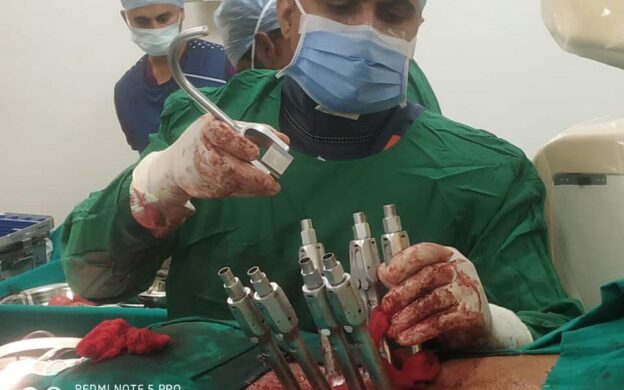Lumbar Canal Stenosis – Get Best MIS Spine Surgery In Guntur
Most people experience relief from their symptoms with nonsurgical treatments. However, surgery may be an option if your symptoms are severe and impact your quality of life. Surgery involves widening the spinal canal to relieve pressure on the spinal cord or nerves. In Guntur, the best spine surgery specialists available at Dr. Rao’s hospital will help you understand and deal with your spinal stenosis problem effectively in terms of medical and surgical management in a patient-centric environment.
Lumbar canal stenosis is a condition that narrows the spinal canal in your lower back. It can cause pain, numbness, and weakness in your legs. LCS has been seen in people over age 60. There are several treatment options available.
Causes:
The narrowing of the spinal canal causes lumbar canal stenosis. This can be due to several things, including:
-A herniated disc
-Bone spurs
-Thickening of the ligaments
-Tumors
Symptoms: Symptoms of lumbar canal stenosis include:
-Pain in the legs
-Numbness in the legs
-Weakness in the legs
-Difficulty walking
Treatment: There are many treatments available for lumbar canal stenosis. These include:
-Physical therapy
-Exercise
-Weight loss
-Surgery
Physiotherapy:
Physiotherapy is the first line of treatment option for lumbar canal stenosis. Physical therapy can help strengthen the spine’s muscles and improve the range of motion.
Exercise:
Exercise is another treatment option for lumbar canal stenosis. Exercise can help strengthen the spine’s muscles and improve the range of motion.
Weight loss:
Weight loss can also help to treat lumbar canal stenosis. Weight loss can help to reduce the amount of pressure on the spine.
Surgery:
Surgery is a treatment option for lumbar canal stenosis. Surgery can help to decompress the spine and relieve pressure on the nerves.
- Laminotomy: Removal of the part of the lamina
- Foraminotomy: Removal of small bone and making the neural foramina wider
- Medial Facetectomy: Removal of the lamina and the medial facet joints.
- Anterior Lumbar Interbody Fusion
- Anterior lumbar interbody fusion, or ALIF, is a surgical procedure that relieves pain in the lower back and legs. The surgery involves fusing vertebrae in the spine using metal rods and screws. ALIF can help to stabilize the spine and reduce pain by preventing movement between the vertebrae. ALIF is typically performed as an outpatient procedure, meaning patients can go home the same day as their surgery. Recovery time varies depending on the individual, around four to six weeks.
- Posterior Lumbar Interbody Fusion (PLIF): spine surgery that is performed through the back. This type of surgery aims to meld together the vertebrae to stabilize the spine. :
- Transforaminal Lumbar Interbody Fusion (TLIF): A surgical procedure is performed to remove the degenerative disk from the back, and a structural device is placed to take the supportive role. This process can eventually lead to fusion between the bones above and below.
- Posterolateral Fusion:
- Instrumented Fusion:
Conclusion:
Lumbar canal stenosis is a condition that can cause pain, numbness, and weakness in the legs. Treatment options include physiotherapy, exercise, weight loss, and surgery. Are you looking for the best spine surgeon in Guntur? Look no further than Dr. Rao’s hospital. Our specialists are experts in minimally invasive spine surgery and can help you get relief from your symptoms quickly and effectively. Contact us today to learn more.


